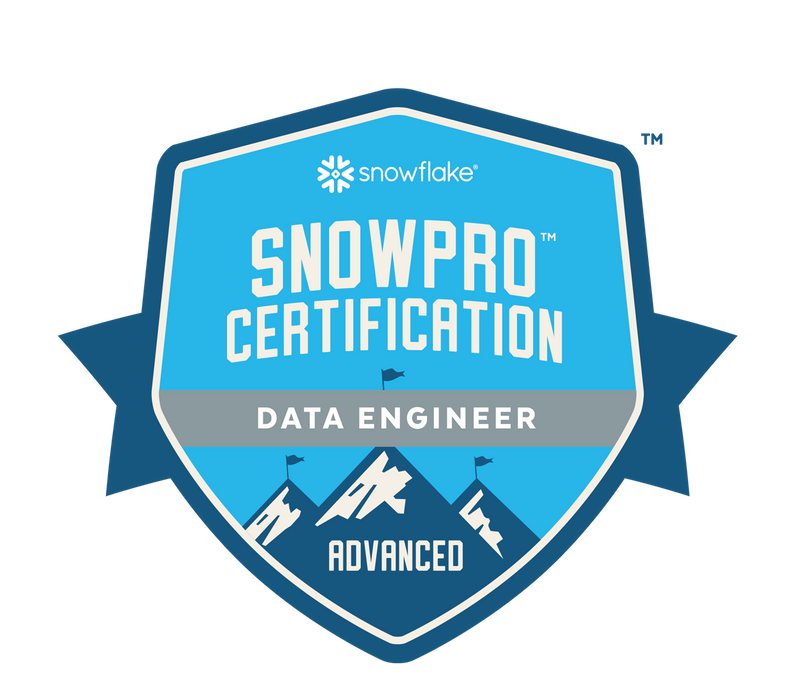Description
SnowPro® Advanced: Data Engineer Overview
The SnowPro® Advanced: Data Engineer Certification will test advanced knowledge and skills used to apply comprehensive data engineering principles using Snowflake. This certification will test the ability to:
- Source data from Data Lakes, APIs, and on-premises
- Transform, replicate, and share data across cloud platforms
- Design end-to-end near real-time streams
- Design scalable compute solutions for Data Engineer workloads
- Evaluate performance metrics
SnowPro® Adavanced: Data Engineer Candidate
2 + years of hands-on Snowflake Practitioner experience in a Data Engineering role.
Target Audience:
- Data Engineers
- Software Engineers
Exam Format:
- Exam Version: DEA-C01
- Total Number of Questions: 65
- Question Types: Multiple Select, Multiple Choice
- Time Limits: 115 minutes
- Language: English
- Registration fee: USD 375
- Passing Score: 750 + Scaled Scoring from 0 – 1000
Unscored Content:
Exams may include unscored items to gather statistical information for future use. These items are not identified on the form and do not impact your score, and additional time is factored into account for this content.
Prerequisites:
SnowPro Core Certified
Delivery Options:
- Online Proctoring
- Onsite Testing Centers
Exam Domain Breakdown:
This exam guide includes test domains, weightings, and objectives. It is not a comprehensive listing of all the content that will be presented on this examination. The table below lists the main content domains and their weightings.
| Domain | Weightings on Exams |
| 1.0 Data Movement | 25-30% |
| 2.0 Performance Optimization | 20-25% |
| 3.0 Storage and Data Protection | 10-15% |
| 4.0 Security | 10-15% |
| 5.0 Data Transformation | 25-30% |
Exam Topics:
Outlined below are the Domains & Objectives measured on the exam. To view subtopics, download the exam study guide.
Data Movement
- Given a data set, load data into Snowflake.
- Ingest data of various formats through the mechanics of Snowflake.
- Troubleshoot data ingestion.
- Design, build, and troubleshoot continuous data pipelines.
- Analyse and differentiate types of data pipelines.
- Install, configure, and use connectors to connect to Snowflake.
- Design and build data-sharing solutions.
- Outline when to use external tables and define how they work.
Performance Optimization
- Troubleshoot underperforming queries.
- Given a scenario, configure a solution for the best performance.
- Outline and use caching features.
- Monitor continuous data pipelines.
Storage and Data Protection
- Implement data recovery features in Snowflake.
- Outline the impact of streams on Time Travel.
- Use system functions to analyse micro-partitions.
- Use Time Travel and cloning to create new development environments.
Security
- Outline Snowflake security principles.
- Outline the system-defined roles and when they should be applied.
- Manage data governance.
Data Transformation
- Define User-Defined Functions (UDFs) and outline how to use them.
- Define and create external functions.
- Design, build, and leverage stored procedures.
- Handle and transform semi-structured data.
- Use Snowpark for data transformation.
TABLE OF CONTENTS
1.0 Domain: Data Movement
1.1 Given a data set, load data into Snowflake.
- Outline considerations for data loading
- Define data loading features and potential impact
1.2 Ingest data of various formats through the mechanics of Snowflake.
- Required data formats
- Outline Stages
1.3 Troubleshoot data ingestion.
1.4 Design, build, and troubleshoot continuous data pipelines.
- Design a data pipeline that forces uniqueness but is not unique
- Stages
- Tasks
- Streams
- Snowpipe
- Auto ingest as compared to Rest API
1.5 Analyze and differentiate types of data pipelines.
- Understand Snowpark architecture (client vs server)
- Create and deploy UDFs and Stored Procedures using Snowpark
- Design and use the Snowflake SLQ API
1.6 Install, configure, and use connectors to connect to Snowflake.
1.7 Design and build data-sharing solutions.
- Implement a data share
- Create a secure view
- Implement row-level filtering
1.8 Outline when to use External Tables and define how they work.
- Partitioning external tables
- Materialized views
- Partitioned data unloading
2.0 Domain: Performance Optimization
2.1 Troubleshoot underperforming queries.
- Identify underperforming queries
- Outline telemetry around the operation
- Increase efficiency
- Identify the root cause
2.2 Given a scenario, configure a solution for the best performance.
- Scale-out as compared to scale-in
- Clustering as compared to increasing warehouse size
- Query complexity
- Micro partitions and the impact of clustering
- Materialized views
- Search optimization
2.3 Outline and use caching features.
2.4 Monitor continuous data pipelines.
- Snowpipe
- Stages
- Tasks
- Streams
3.0 Domain: Storage and Data Protection
3.1 Implement data recovery features in Snowflake.
- Time Travel
- Fail-safe
3.2 Outline the impact of Streams on Time Travel.
3.3 Use System Functions to Analyze Micro-partitions.
- Clustering depth
- Cluster keys
3.4 Use Time Travel and Cloning to create new development environments.
- Backup databases
- Test changes before deployment
- Rollback
4.0 Domain: Security
4.1 Outline Snowflake security principles.
- Authentication methods (Single Sign On (SSO), Key Authentication, Username/Password, Multi-factor Authentication (MFA))
- Role Based Access Control (RBAC)
- Column Level Security and how data masking works with RBAC to secure sensitive data
4.2 Outline the system-defined roles and when they should be applied.
- The purpose of each of the system-defined roles including best practices used in each case
- The primary differences between SECURITYADMIN and USERADMIN roles
- The difference between the purpose and usage of the USERADMIN/SECURITYADMIN roles and SYSADMIN
4.3 Manage Data Governance.
- Explain the options available to support column-level security including Dynamic Data Masking and External Tokenization
- Explain the options available to support row-level security using Snowflake Row Access Policies
- Use DDL required to manage Dynamic Data Masking and Row Access Policies
- Use methods and best practices for creating and applying masking policies on data
- Use methods and best practices for Object Tagging
5.0 Domain: Data Transformation
5.1 Define User-Defined Functions (UDFs) and outline how to use them.
- Secure UDFs
- SQL UDFs
- JavaScript UDFs
- Returning table value compared to a scalar value
5.2 Define and create External Functions.
Secure external functions
5.3 Design, build, and leverage Stored Procedures.
Transaction management
5.4 Handle and transform semi-structured data.
- Traverse and transform semi-structured data to structured data
- Transform structured to semi-structured data
5.5 Use Snowpark for data transformation.
- Query and filter data using the Snowpark library
- Perform data transformations using Snowpark (ie., aggregations)
- Join Snowpark dataframes
Contact Locus IT support team for further training details.







Reviews
There are no reviews yet.